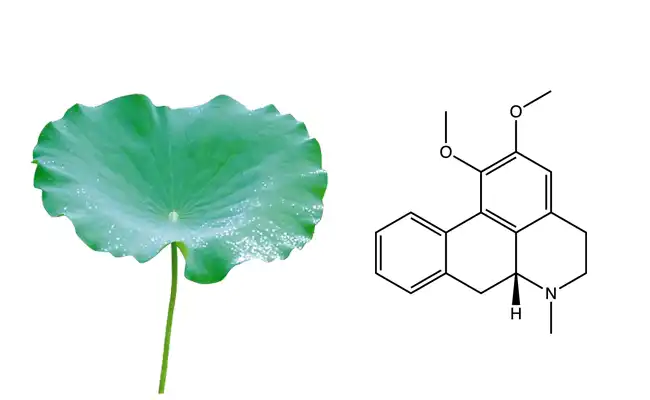What is Nuciferine
2024-04-19 23:23:33
Nuciferine powder, you can't miss to lose weight and lower blood lipids. In recent years, domestic and foreign scholars have conducted systematic research on lotus leaves and found that they mainly contain alkaloids, flavonoids, volatile oils and other components. Among them, flavonoids and alkaloids have high biological activity. Therefore, people have increased their attention to these two kinds of compounds in recent years. Pharmacological research shows that lotus leaves mainly have lipid-lowering and weight-loss, antioxidant and anti-aging, and antibacterial effects.

What Plants have Nuciferine in Them?
Nuciferine is primarily found in plants, and one of the most well-known sources is the sacred lotus (Nelumbo nucifera). However, it's also present in other plant species. Here are some plants known to contain nuciferine:
Sacred Lotus (Nelumbo nucifera): The lotus plant, particularly its seeds and leaves, is a rich source of nuciferine. The sacred lotus has cultural significance in many Asian countries and is often used in traditional medicine.
Nymphaea caerulea (Blue Lotus or Blue Lily): This water lily, native to Egypt, contains nuciferine as well. It has been used historically in traditional medicine and also has psychoactive properties.
Nelumbo lutea (American Lotus): Another species of lotus, the American lotus, also contains nuciferine. It is native to North America.
Nelumbo lutea (Yellow Lotus): This is another species of lotus that can contain nuciferine.
In the lotus plant, nuciferine is found in various parts, including the leaves, seeds, and stems. It has been studied for its potential pharmacological properties and has been found to exhibit various effects, although research is ongoing, and more studies are needed to fully understand its potential applications.
Main chemical components of lotus leaves:
●Flavonoids:
At present, nympholide A, nympholide B, myricetin-3-0-(6-p-oumaroyl)glucoside, quercetin, kaempferol, rutin, and quercetin-3-O-glucuronic acid, quercetin-3-propyl ester, isoquercitrin and hyperoside and other at least ten kinds of flavonoids have been isolated from lotus leaves. Mainly nuciferin, followed by common flavonoids such as quercetin and isopretin. Research shows that lotus leaf flavonoids have the functions of antioxidant, anti-aging, lowering blood lipids, lowering cholesterol and treating cardiovascular and cerebrovascular diseases.
●Alkaloids:
So far, 3 monomer components and 16 alkaloid compounds have been isolated from lotus leaves. The five main alkaloids are Nuciferine, N-Nomuciferine, Anonaine, Pronuciferine, and Armepavine. Nuciferine is the main lipid-lowering active ingredient in lotus leaves.
Volatile Essential Oils:
The volatile essential oils in lotus leaves have various components, mainly monoterpenes, saturated fatty acids, alkaloids and aliphatic hydrocarbons. The main ingredients include trans-caryophyllene, trans-isolimonene, white calamus terpene, etc.
●Organic acids:
Tartaric acid, citric acid, malic acid, oxalic acid, gluconic acid, succinic acid, gallic acid, n-octadecanoic acid, benzoic acid, o-hydroxybenzoic acid and other organic acids and non-volatile organic acids are found in lotus leaves.
●Other ingredients:
Lotus leaves also contain β-sitosterol, carotene, β-carotene, tannins, soaps, steroids, vitamin C, lotus leaf polyphenols, proanthocyanidins, carbohydrates, lipids, proteins, lotus leaf polysaccharides and alkaline component of mitosis.
Nuciferine Solubility:
Is Nuciferine Soluble in Water?
Nuciferine is sparingly soluble in water. Generally, alkaloids like nuciferine tend to be more soluble in organic solvents such as ethanol, methanol, or acetone, compared to water. This limited water solubility can influence the ways in which nuciferine is extracted from plants for research or commercial purposes.

What are the Properties of Nuciferine?
Anti-obesity: Nuciferine has been investigated for its potential anti-obesity effects, as it may influence lipid metabolism and adipocyte differentiation.
Antioxidant: Studies have suggested that nuciferine powder may have antioxidant properties, helping to combat oxidative stress in the body.
Anti-inflammatory: Some research indicates that it may have anti-inflammatory effects, which could be beneficial in addressing inflammatory conditions.
Anti-diabetic: There is preliminary evidence suggesting that it may have an impact on blood glucose levels, which could be relevant in the context of diabetes.
Antibacterial and antiviral: Lotus leaves contain many alkaline components, such as nuciferine, N-desmethylnuciferine, D-N-methylhigenine, tomatine, etc. These alkaline components can inhibit mitosis and have the effect of Strong antibacterial effect. In addition, the flavonoids, volatile oils, soaps, and glycosides in lotus leaves also have certain antibacterial activity.
Nuciferine Applications:
Used in medicine:
The most clinical application of lotus leaves is in the form of compound formulas for weight loss and lipid-lowering.
Application in food and health products:
Lotus leaf extract products currently on the market include: lotus leaf tablet candies, compound lotus leaf granules, mixtures, capsules, various lotus leaf health teas, fruity lotus leaf juice, lotus leaf honeysuckle health chewing gum, lotus leaf health toothpaste, Lotus leaf honey health lozenges, etc. Mainly used for weight loss and prevention of coronary heart disease, hypertension, diabetes, and cerebrovascular disease.
As a lotus leaf extract manufacturer and supplier, we can supply different specifications of lotus leaf extract powder, processing and so on. Please send inquiry to Email: admin@chenlangbio.com if you want to buy nuciferine powder.
Send Inquiry
Related Industry Knowledge
- What Pure Nature Raspberry Ketone Good For
- What is Nmn powder Supplement Used for
- What is Resveratrol Extract Powder Good for
- What is Melatonin Extract Powder
- How much Olive Leaf Extract Powder Oleuropein Should I Take
- Does Cyanotis Arachnoidea Extract Ecdysone Can Use in Cosmetic Products
- External Standard Method Fisetin Powder Factory
- Phenylethyl Resorcinol Skin Benefits
- Are Ecdysterone and Turkesterone the Same
- Who Shouldn't Consume Curcumin or Turmeric

